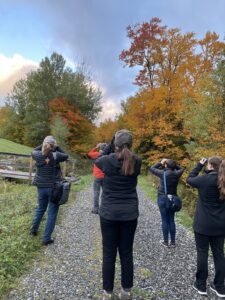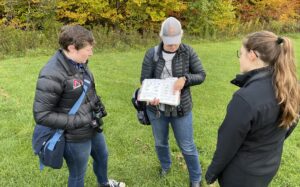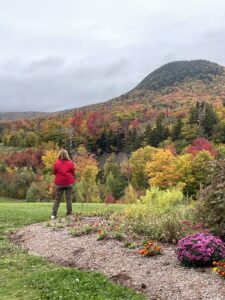What is a Bird Diva?
We’d only walked a short way when Bridget Butler stopped our small group. “Look at the top of that tree. See the bird,” she asked.
We did, and from long experience knew its species, but Bridget’s coaching helped us become better birders.
“Notice its size. Is it bigger/smaller than a sparrow”? (Bigger). Colors? (reddish/brownish).
Bridget was teaching us her method of slow birding. It’s an effective way to spot birds and figure out the species.
Slow Birding
We were in Vermont to attend the conference of the Outdoor Writer’s Association of America at Jay Peak ski resort tucked up near Canada. The Peak’s ashes, maples, and aspens were in glorious full color on the early October morning. Up early, we had met Bridget and other conference attendees in the hotel lobby.
Bridget slowly led us just past the parking lot, eyes and ears open for the slightest movement or chirp. We spotted and heard birds that a hasty walk would have bypassed.
What to Look and Listen For
Bridget’s suggestions for identifying a bird include:
Listen carefully. Often, it’s easier to distinguish a species by sound rather than sight. Close your eyes to help focus on sound.
Observe size. Compare the bird to common, landmark species. Is the bird bigger /smaller than a sparrow or robin or crow, for example?
Observe color/Patterns. Where is the most color on the bird? Are there eyelines, streaking on the breast?
Observe activity. Is the bird perched high in a tree or scurrying around in bushes? Is it solitary or in a flock?
Observe the habitat. Coniferous woods, hardwood forest, brush, grassy, marsh.
The bird we first spotted high in a spruce tree was a common American Robin, one of the most visible and recognizable of all birds. It provided Bridget with an example of how to help birding newcomers to learn species. And, was a reminder to experienced birders to slow down and observe more and be concerned less with adding to “the list.”
Various Habitats
Our walk took us from a mowed lawn through a dense sugar maple wood and around to a delightful pond at Jay Peak’s base. While in the woods a barred owl responded to Bridget’s call.
When we emerged from the woods to the open pond, we spotted a knot of ducks swimming on the far end. “Let’s walk slowly and see how close we can get,” she said. She suggested we avoid looking directly at the ducks – pretending that we didn’t know they were there. It worked! The ducks seemed unconcerned about our slow pace toward them yet instantly took flight when a jogger appeared on the other side of the pond.
Ring-Billed ducks! A thrilling sight as the colorful and agile birds winged against the backdrop of Jay Peak’s autumn splendor.
- Pause to listen and look. Binoculars help.
- Bridget sharing identification tips with birders.
- Varied elevations and habitats offered excellent birding.
Anyone heading for Vermont might want to join one of Bridget’s walks. If not, her slow birding technique works well anywhere. Her business is called Bird Diva Consulting. She leads bird walks, inventories birds, provides landowner assistance, and does presentations. Her website is birddiva.com.





Bridget has the right idea about bird watching. I follow her directions each day and that’s how I’ve identified numerous small birds that come to my feeders like the Pine Siskin. Such great fun!